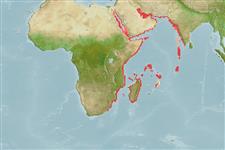>
Ovalentaria/misc (Various families in series Ovalentaria) >
Opistognathidae (Jawfishes)
Etymology: Opistognathus: Greek, opisthe = behind + Greek, gnathos = jaw (Ref. 45335); to the very elongate upper jaw of the type species of the genus, Opistognathus nigromarginatus (Ref. 128653); muscatensis: Named for the type locality Muscat, Oman..
More on author: Boulenger.
Environment: milieu / climate zone / depth range / distribution range
Ecologia
marinhas associadas(os) a recifes; intervalo de profundidade 15 - 50 m (Ref. 9710), usually 30 - 50 m (Ref. 27115). Tropical; 18°C - 24°C (Ref. 27115)
Western Indian Ocean: Durban, South Africa to the Persian Gulf, including Mahé Island, Seychelles (Ref. 5468). Not in Red Sea (Ref. 84159).
Tamanho / Peso / Idade
Maturity: Lm ? range ? - ? cm
Max length : 45.0 cm TL macho/indeterminado; (Ref. 9710); common length : 30.0 cm TL macho/indeterminado; (Ref. 5450)
Espinhos dorsais (total): 11; Raios dorsais moles (total): 15; Espinhos anais 3; Raios anais moles: 15. This species is distinguished by the following characters: short supramaxilla and mostly rigid maxilla with only a slight flexible lamina posteriorly; an ocellated spot on the dorsal fin, between third or fourth and eighth spines followed by two large, irregular, dark blotches that extend onto body, and a blackish streak on cheek bordering upper edge of maxilla; outermost segmented pelvic-fin ray is tightly bound to adjacent ray, with interradial membrane not incised distally or only slightly at tip (vs. interradial membrane deeply incised in all other Indo-Pacific Opistognathus (Ref. 81517).
Black spot between 3rd and 8th dorsal fin spines, fin also with 2 large blotches that extend onto body; body and dorsal fin with spots and blotches bordered with pale blue (Ref. 5468).
This species is occasionally encountered in the fish market and its flesh is reported to be relatively good. It is taken incidentally in bottom trawls and by hook and line at 30-50 m (Ref. 81517).
Life cycle and mating behavior
Maturidade | Reprodução | Desova | Ovos | Fecundidade | Larvas
Smith-Vaniz, W.F., 1986. Opisthognathidae. p. 726-727. In M.M. Smith and P.C. Heemstra (eds.) Smiths' sea fishes. Springer-Verlag, Berlin. (Ref. 5468)
Categoria na Lista Vermelha da IUCN (Ref. 130435)
Ameaça para o homem
Harmless
Utilização humana
Aquário: Espécies comerciais
Mais informação
Nomes comunsSinónimosMetabolismoPredadoresEcotoxicologiaReproduçãoMaturidadeDesovaAgregação para desovaFecundidadeOvosDesenvolvimento dos ovos
ReferênciasAquaculturaPerfil para aquaculturaEstirpesGenéticaElectrophoresesHereditariedadeDoençasProcessamentoNutrientsMass conversion
ColaboradoresFotografiasStamps, Coins Misc.SonsCiguateraVelocidadeTipo de nataçãoÁrea branquialOutras referênciasCérebrosVisão
Ferramentas
Relatórios especiais
Descarregue XML
Fontes da internet
Estimates based on models
Preferred temperature (Ref.
123201): 22.4 - 28.3, mean 26 °C (based on 73 cells).
Phylogenetic diversity index (Ref.
82804): PD
50 = 0.5000 [Uniqueness, from 0.5 = low to 2.0 = high].
Bayesian length-weight: a=0.00389 (0.00180 - 0.00842), b=3.12 (2.94 - 3.30), in cm total length, based on all LWR estimates for this body shape (Ref.
93245).
Nível Trófico (Ref.
69278): 3.8 ±0.6 se; based on size and trophs of closest relatives
Fishing Vulnerability (Ref.
59153): Low to moderate vulnerability (35 of 100).
